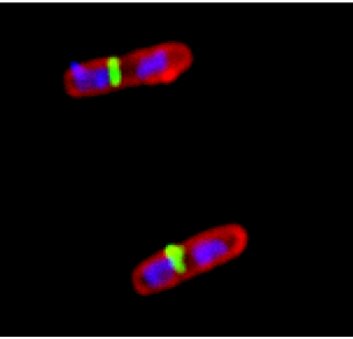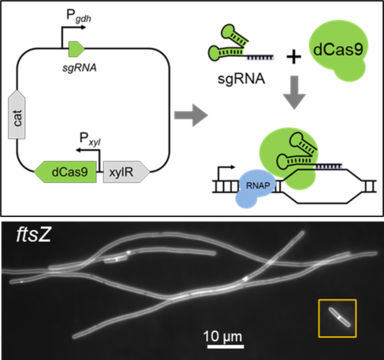Breadcrumb
- Home
- Research
Research

Cell division E. coli Escherichia coli is one of the (usually) harmless bacteria that inhabits our lower intestines. E. coli’s primary claim to fame is that it serves as a model organism for addressing bacterial genetics and physiology at the molecular level. We use E. coli as a model system for understanding cell division in Gram-negative bacteria. Cell division in E. coli is mediated by a consortium of over 30 types of proteins that assemble into a contractile ring-like structure at the division site (the midcell). This assemblage is usually referred to as the divisome. Ongoing experiments in our b are focused on assigning specific biochemical functions to the divisome proteins and figuring out how they work together to convert a mother cell into two daughter cells. Some of our studies are done in collaboration with Jie Xiao, PhD, an expert in super-resolution microscopy and single-molecule tracking at Johns Hopkins University. |
|
|
|
|
|
Cell envelope biogenesis in C. difficile 
Clostridioides difficile is a Gram-positive, strictly anaerobic, spore-forming bacterium, and the leading cause of inflammatory diarrhea in industrialized countries. C. difficile infections kill upwards of 30,000 people in the United States each year, prompting the CDC to declare this organism an “urgent” threat to public health, the highest threat category. Our research seeks to better understand the basic biology of cell envelope biogenesis in C. difficile. Importantly, the cell envelope has several unusual features that might be exploited to develop drugs that target C. difficile selectively. These unusual features include a proteinaceous surface-layer (S-layer) and an atypical peptidoglycan with primarily 3-3 peptide crosslinks rather than the 4-3 crosslinks that predominate in most bacteria. Our studies rely heavily on tools we have developed, including fluorescent protein reports and a CRISPR interference plasmid that we use to silence expression of genes that interest us. Our C. difficile work is done in close collaboration with our colleague Craig Ellermeier, PhD. |
|